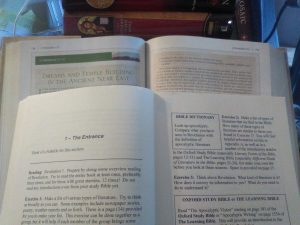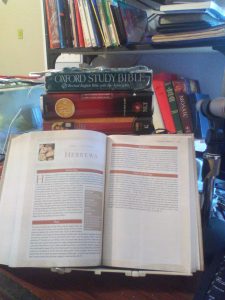NIV Cultural Backgrounds Study Bible
 A little over a week ago I reviewed the NIV Cultural Backgrounds Study Bible using the Olive Tree electronic edition. On Tuesday I received my hardcover copy from the publisher. (Note: I received this copy free of charge in exchange for an honest review. No other strings were attached!) This is not an extraordinarily new experience in Bible editions, but it is a good one.
A little over a week ago I reviewed the NIV Cultural Backgrounds Study Bible using the Olive Tree electronic edition. On Tuesday I received my hardcover copy from the publisher. (Note: I received this copy free of charge in exchange for an honest review. No other strings were attached!) This is not an extraordinarily new experience in Bible editions, but it is a good one.
The Bible is 6″ x 9″, so fits nicely on all my disorderly stacks of books. It’s about 2 1/4″ thick, which makes it substantial, but not the largest Bible I use. The picture at the top shows it in my (not necessarily its) natural environment. That’s my actual desk, and so you can see it in comparison to the other study Bibles I have around it. You can click on the image to see it in high resolution. These days I rarely carry a physical Bible to church, other than my Greek & Hebrew testaments (I have years of marking and marginal notes in them), so I don’t worry that much about the physical size of a study Bible.
physical size of a study Bible.
These days I rarely carry a physical Bible to church, other than my Greek & Hebrew testaments (I have years of marking and marginal notes in them), so I don’t worry that much about the physical size of a study Bible. That said, I can say that I prefer working with the electronic edition of this Bible, even though I am not well-acquainted with Olive Tree software. There is a great deal of information to present, and the size of an edition is always a compromise.
 In this case, the text is small (as is common with study Bibles). The image just below shows it by comparison with my own Revelation: A Participatory Study Guide, which is printed in a 12 point font. The notes appear slightly smaller, though I’m not good enough to say for certain, and the impression may be created by a different (sans-serif) font for the notes. This note on text size is not intended as criticism, but it is one of the major reasons I prefer to use an electronic edition in which I can set font size. This is a problem for just about every study Bible out there. There is so much information to be included that something has to give. Having done page layout on a large number of books myself, I understand this completely.
In this case, the text is small (as is common with study Bibles). The image just below shows it by comparison with my own Revelation: A Participatory Study Guide, which is printed in a 12 point font. The notes appear slightly smaller, though I’m not good enough to say for certain, and the impression may be created by a different (sans-serif) font for the notes. This note on text size is not intended as criticism, but it is one of the major reasons I prefer to use an electronic edition in which I can set font size. This is a problem for just about every study Bible out there. There is so much information to be included that something has to give. Having done page layout on a large number of books myself, I understand this completely.
The biblical text is printed in two columns with reference notes in the center. This is a classical style of presentation, but not one of my favorites. Again, I should emphasize that nobody can avoid all criticisms for the layout of a text. Doubtless others would complain about a single column with notes on the outer margins, for example. The double-column format is so standard that I have only a couple of Bibles that don’t follow it. An excellent example is The Jewish Study Bible (JPS Tanakh Translation), which uses a single column for the text with notes consistently in a narrower column to the right. I find their edition quite friendly.
There are a variety of excurses and notes included directly in the text section, besides the standard notes which are in two columns at the bottom of the page. The notes supplement and follow-up on the introduction, generally providing information that is applicable on a wider basis, i.e. not to just the text in question. For example, just before the text of Isaiah we have an introduction to “The Oracles of the Prophets,” followed by a short introduction to the book of Isaiah itself. But about three pages in we have a nearly three-page section titled “The Historical Background of Isaiah,” which provides a great deal of helpf ul information that will also relate to others of the prophets.
ul information that will also relate to others of the prophets.
But just after these sections, on p. 1122, is an inset titled “Dating Methods.” No, this is not for those of you interested in origins and how rocks and fossils might be dated. Rather, it presents the basics of how one tries to place a particular oracle at a particular date. This is a tightly packed, extremely useful essay. Everyone should read it, no matter what portion of the Bible you’re studying. That’s why I chose Isaiah for this brief tour!
I mentioned that I will comment on some more specifics regarding the book of Hebrews. I will do so, but this past week has been intense, and I didn’t yet get to it. Nonetheless, the picture to the left at this point is the introduction to the book of Hebrews. I will go through that introduction in more detail in a post I hope to publish by Saturday.
Having the physical copy of this Bible in my hands makes me completely comfortable in recommending it. It’s easier to scan the portions I’m not emphasizing. For example, in using an electronic version I rarely “leaf through” the book, and thus might have missed the excellent introductory material for Isaiah. My main concern with study Bibles is that people tend to take the word of the note writer as to the meaning of the text. It’s certainly appropriate and valuable to get the opinions of others, but when one doesn’t find out why the writer believes a certain thing, one is left with either accepting it on authority—surely the author of such a fine volume would have his facts straight!—or having to dig elsewhere for that background information. That’s the value of this type of explanation.
For a few more notes on study Bibles in English, see my aer.io store collection.






